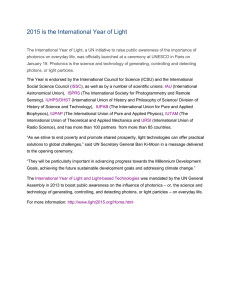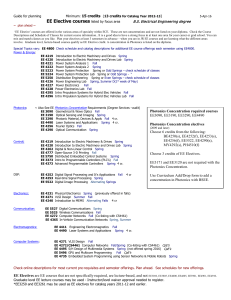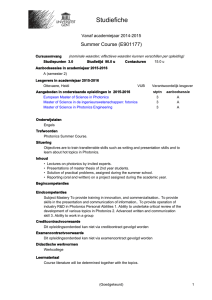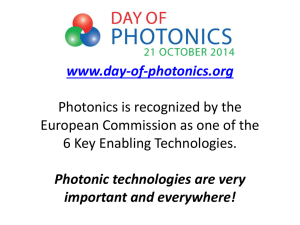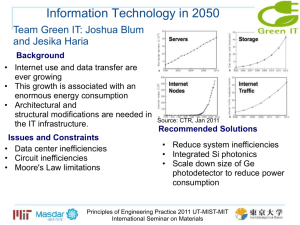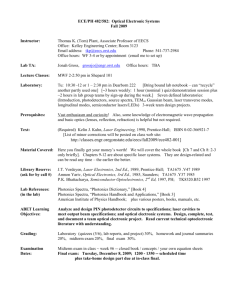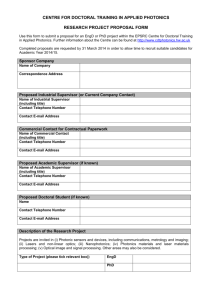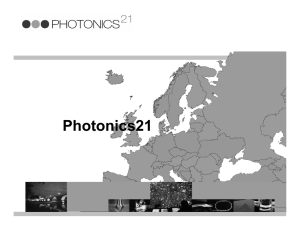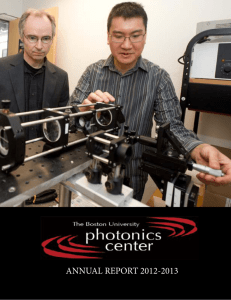Case Study Exercise
advertisement
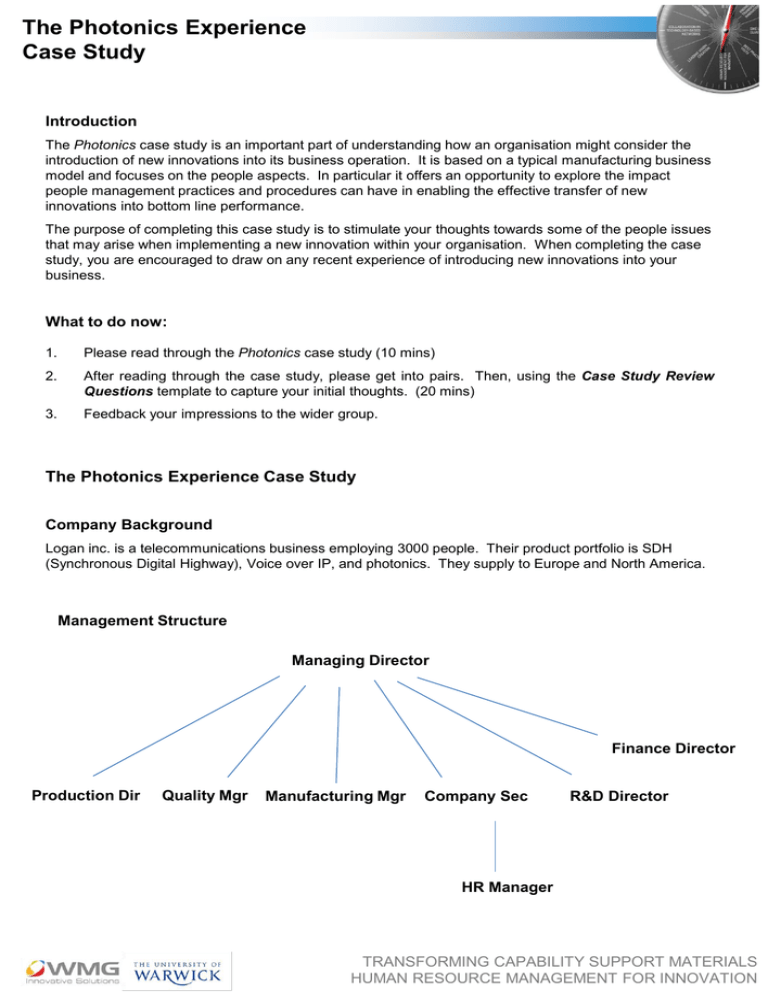
The Photonics Experience Case Study Introduction The Photonics case study is an important part of understanding how an organisation might consider the introduction of new innovations into its business operation. It is based on a typical manufacturing business model and focuses on the people aspects. In particular it offers an opportunity to explore the impact people management practices and procedures can have in enabling the effective transfer of new innovations into bottom line performance. The purpose of completing this case study is to stimulate your thoughts towards some of the people issues that may arise when implementing a new innovation within your organisation. When completing the case study, you are encouraged to draw on any recent experience of introducing new innovations into your business. What to do now: 1. Please read through the Photonics case study (10 mins) 2. After reading through the case study, please get into pairs. Then, using the Case Study Review Questions template to capture your initial thoughts. (20 mins) 3. Feedback your impressions to the wider group. The Photonics Experience Case Study Company Background Logan inc. is a telecommunications business employing 3000 people. Their product portfolio is SDH (Synchronous Digital Highway), Voice over IP, and photonics. They supply to Europe and North America. Management Structure Managing Director Finance Director Production Dir Quality Mgr Manufacturing Mgr Company Sec R&D Director HR Manager TRANSFORMING CAPABILITY SUPPORT MATERIALS HUMAN RESOURCE MANAGEMENT FOR INNOVATION The Photonics Experience Case Study Culture The overarching management style is target driven and authoritative. There is a small HR department which manages formal people-related activities such as recruitment and welfare. Learning and development is stated to be important, and the company has Investors in People (IIP) status. However, due to budgetary constraints most training is technical and done in response to specific skills gaps. There is the unwritten rule that managers will have enough previous experience to know how to manage people. The company ensures it communicates on a need-to-know basis. Drivers for Innovation The telecommunications market is very competitive. During 2001, Logan inc. recognized that it was beginning to lose its market share. In-order to address this, the following company members met up to discuss the situation: the Managing Director, Finance Director, Production Director, and the Research and Development Director. It was decided that a Mark II Photonic product should be developed to meet a niche need within the market. It was acknowledged that existing photonics skills within the company were inadequate, and that a new Research and Development (R&D) Photonics team would have to be created through recruitment. Key Steps in the Innovation Project An R&D team specializing in photonics was recruited, and work started on developing the prototype in June 2002. In January 2004 the R&D department completed work on the photonics prototype product “ML2006”. This was evaluated by the board and they agreed that the product should be launched in June 2005. The Production Director was assigned as the project manager. In September 2004 the Production Director went into discussions with equipment manufacturers and purchased new production technology to manufacture the new product, for delivery in March 2005. He discussed the project with the Operations Manager and Production Engineering team, who between them developed plans for plant layout, standard operating processes and manpower allocations. It was felt that any necessary training would best be done “on the job” once the new equipment had been installed. In April 2005 the new equipment was installed and the Human Resources (HR) / Training Manager devised a training plan to cover all the aspects needed to work the new technology. Four training sessions were developed from this plan. The HR / Training manager acknowledged that not everyone would need to attend all of the sessions. Supervisors were asked to use their personal knowledge of their employees’ skills, and assign them to the relevant courses. During May – June 2005 all employees attended the relevant courses, and following this, production of ML2006 commenced, in line with the original timing plan. The HR / Training manager asked managers to observe their employees and if they had any difficulties in performing the new tasks, to inform HR so that more training could be put in place. During July to October 2005 production volumes were very low. A number of people were identified as not performing satisfactorily with the new technology. A decision was made by the Production Director to reassign some of the under performing shop-floor members to another department and bring some new employees into their position; selection again being based on personal judgment. These changes caused upset on the shop floor and employees decided to work to rule for a month. Production was severely affected during this time. Meetings were held with the employees and HR and the problems were eventually resolved. By November 2005, all employees had received the necessary technical training, and production was reaching the minimum needed to meet the orders placed. Unfortunately this was five months behind schedule, and business results were considerably below forecasted levels. TRANSFORMING CAPABILITY SUPPORT MATERIALS HUMAN RESOURCE MANAGEMENT FOR INNOVATION The Photonics Experience Case Study Case Study Review Questions Key Theme Key Questions to Consider Organisational level people management practices to enable innovation How have the following helped or hindered the introduction of new innovations at the organisational level? Innovation project level people management practice to enable innovation How have the following helped or hindered at the innovation project level? information gathering strategy resourcing implementation Your Comments on the Case Study training policy communication systems people management strategy Information Gathering - Communication to employees of potential changes. Environment in which project team chose the new innovation. Project Planning – Communication of why the new innovation is being brought in. The company’s ability to define and measure success. Resourcing – Communication to employees about the changes brought about by the new innovation. The recruitment and resource management. Skills gap analysis process. Redesign of job roles. Implementation – Communication of changes to employees as they happen. Technical training, people management training of managers. Performance management system. Environment once the innovation had been introduced. TRANSFORMING CAPABILITY SUPPORT MATERIALS HUMAN RESOURCE MANAGEMENT FOR INNOVATION The Photonics Experience Case Study The role of senior / line manager in embedding the people management practices to enable innovation. How did the commitment of the senior level management help or hinder the introduction of the new innovation? How have managers helped or hindered at the following stages of the Innovation project level? Information Gathering – In ensuring that necessary support and resource is in place to obtain the correct innovation for the organisation. Project Planning – Taking people issues into consideration. Were all the necessary managers involved in the project planning? If not who was missing and why? Resourcing – Re-design of job roles and description. Communicating to employees. Implementation – Developing and managing their employees. The role of those What role did the HR / training manager play in the responsible for people following: management in embedding the Helping the project management team to practices to enable understand the impact the new innovation would innovation. have on employees. Influencing the project management team to ensure that people management issues were taken incorporated into the strategy. Did they have the necessary skills to be effective? What skills were missing? What role did the HR / training manager play in the following at the innovation project level? Information Gathering – Identifying the right people to gather information on the new innovation. Understanding current skills capability. Project Planning – Involvement in decision making and design of strategy. Understanding how and where to attract scarce skills. Understanding where to obtain training. Resourcing – Providing templates for job descriptions. Supporting re-design of job roles. Supporting implementation of skills gap analysis. Implementation – Supporting the manager to manage their people once innovation implemented. Coaching manager on difficult people management issues. TRANSFORMING CAPABILITY SUPPORT MATERIALS HUMAN RESOURCE MANAGEMENT FOR INNOVATION
